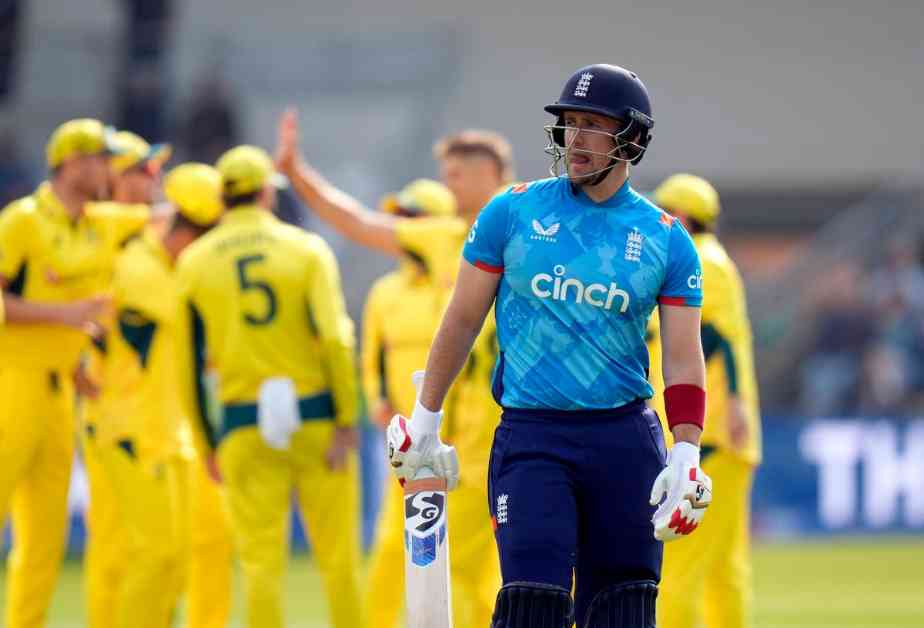**Australia Dominates ODI Series as England Batters Struggle**
England finds themselves in a familiar position, trailing Australia 2-0 in the ODI series after a disappointing batting performance led to a 68-run loss in the second match. Set a target of 271 to win, England’s hopes of leveling the series seemed bleak as they stumbled to 65 for five in just 9.3 overs against an Australia team that featured eight players from their 2023 World Cup final XI.
Jamie Smith, who has been a standout performer in Test cricket this summer, managed to salvage some pride for England with a solid knock of 49 off 61 balls. However, the rest of the team failed to provide substantial support, and England was eventually bowled out for 202 in 40.2 overs. This defeat marks a stark contrast to their performance in the Ashes series just over a year ago, where they managed to turn the tide and secure a thrilling draw after losing the first two Tests.
Despite showing moments of promise, particularly in their bowling performance that limited Australia to 221 for nine, England was unable to capitalize on those opportunities. Alex Carey’s aggressive innings of 74 runs off 67 balls lifted Australia to a competitive total of 270 all out, leaving England with a challenging task to chase down the target.
Josh Hazlewood, returning to the side alongside Mitchell Starc and Glenn Maxwell, played a crucial role in frustrating the English batsmen. Hazlewood and Starc combined to take early wickets, putting England on the back foot from the start. The likes of Phil Salt, Will Jacks, and captain Harry Brook all fell quickly, leaving England in a precarious position.
Despite a brief resurgence from Ben Duckett and some late contributions from Brydon Carse and Adil Rashid, England ultimately fell short of the target set by Australia. Starc, claiming his third wicket, wrapped up the innings as England were bowled out for 202.
**Australia’s Dominant Display**
Australia’s victory was built on a strong batting performance, with Travis Head and Matthew Short setting the tone early on. Head, coming off a match-winning century in the previous game, and Short looked comfortable at the crease before being dismissed for 29 each. The middle order, led by Mitch Marsh’s fluent 60, added crucial runs to the total.
Despite a mini-collapse towards the end of their innings, Australia managed to post a competitive score of 270 all out. England’s bowlers put up a fight, with Matthew Potts and Brydon Carse picking up key wickets, but were unable to contain the Australian batsmen completely.
Alex Carey’s composed innings, supported by a stubborn Josh Hazlewood towards the end, ensured that Australia finished with a score that proved to be too much for England to chase down. Carey’s ability to rotate the strike and find boundaries at crucial junctures highlighted his maturity as a batsman.
**England’s Struggles Continue**
England’s batting woes have been a recurring theme in recent matches, with the team failing to string together substantial partnerships or build momentum during their innings. The top order collapse in the second ODI once again exposed their vulnerability against quality bowling attacks.
The absence of key players such as Jofra Archer, who was rested for the match, added to England’s woes as they failed to find a suitable replacement for his pace and control. The lack of depth in their batting lineup was also evident, with the lower order unable to provide the necessary impetus to chase down the target set by Australia.
Despite flashes of brilliance from individual players like Jamie Smith and Ben Duckett, England lacked the collective effort required to mount a successful run chase. The inability to build partnerships and rotate the strike effectively ultimately led to their downfall in the match.
**Looking Ahead**
As the ODI series progresses, England will need to regroup and address their batting issues if they are to stand a chance of making a comeback against Australia. The team will have to reassess their strategies and approach to facing the Australian bowlers in the remaining matches to avoid a series whitewash.
Australia, on the other hand, will be buoyed by their dominant performances in the first two ODIs and will look to maintain their momentum going forward. The depth in their squad and the ability of their players to step up in crucial moments bodes well for their chances of clinching the series.
Overall, the second ODI highlighted the contrasting fortunes of the two teams, with Australia’s clinical display exposing England’s shortcomings. It remains to be seen whether England can turn things around in the upcoming matches and salvage some pride in what has been a challenging series for them so far.












